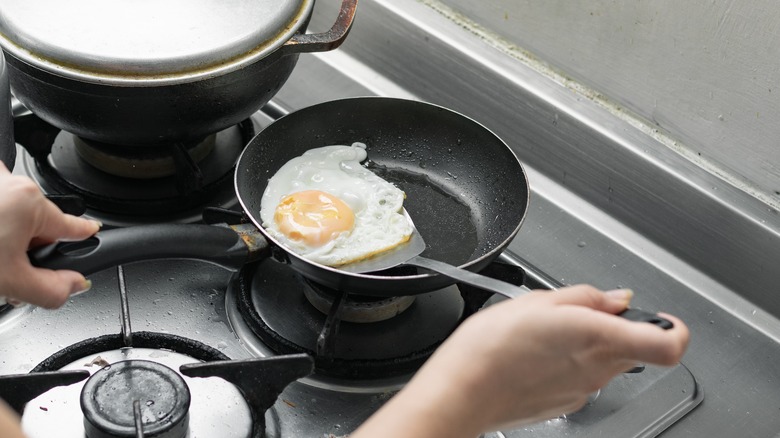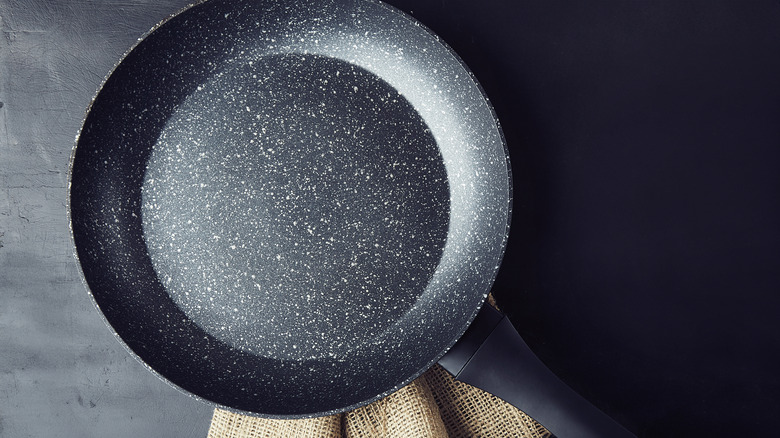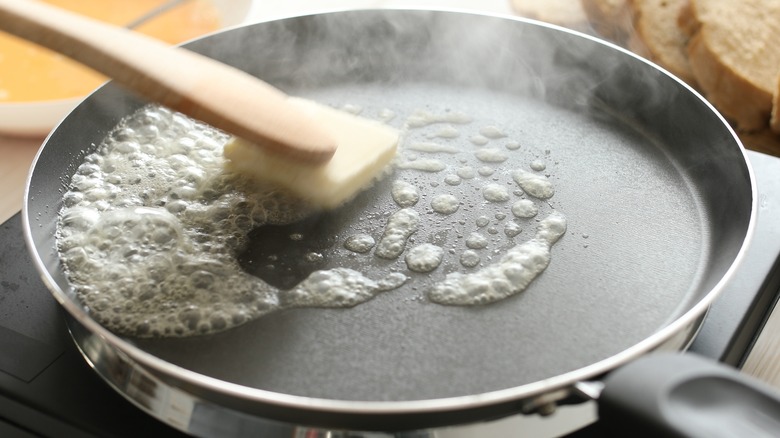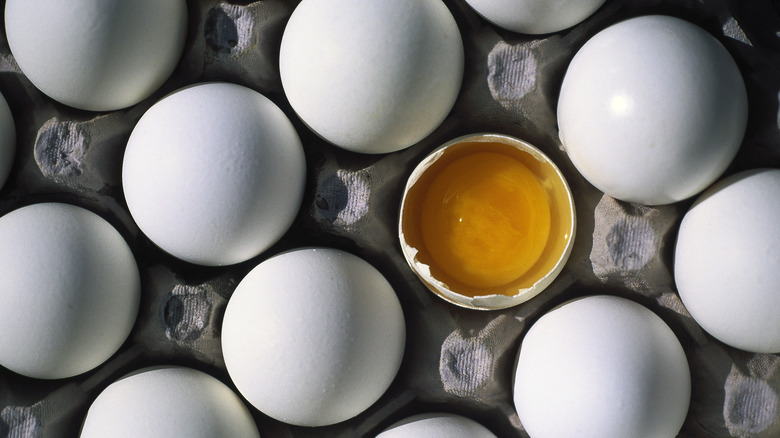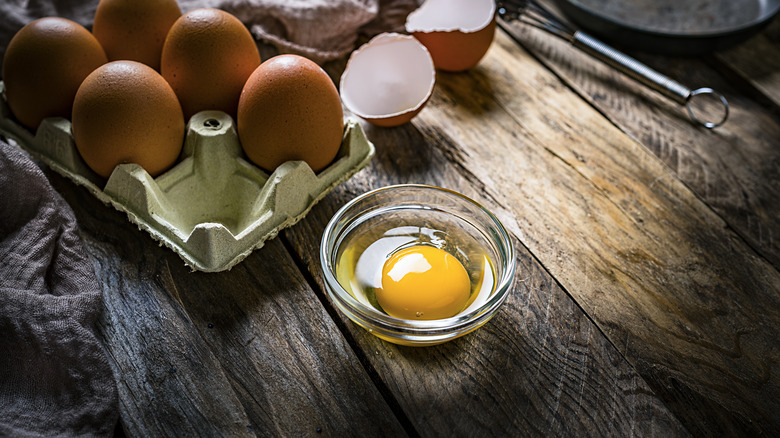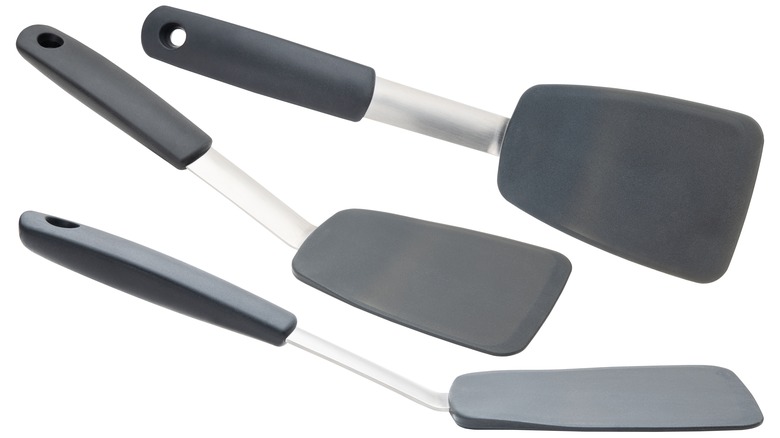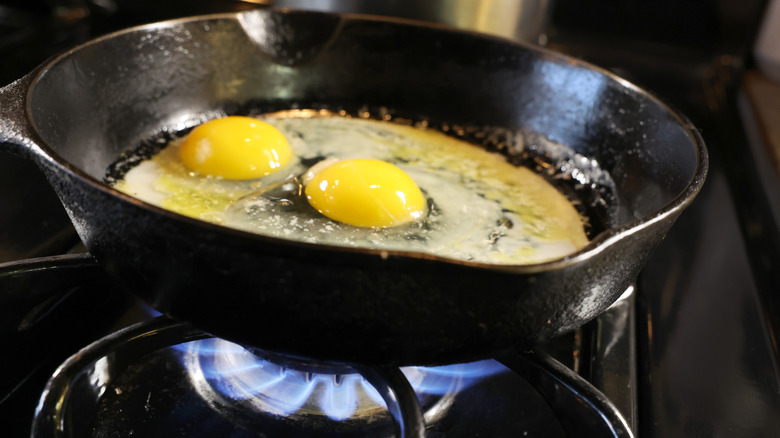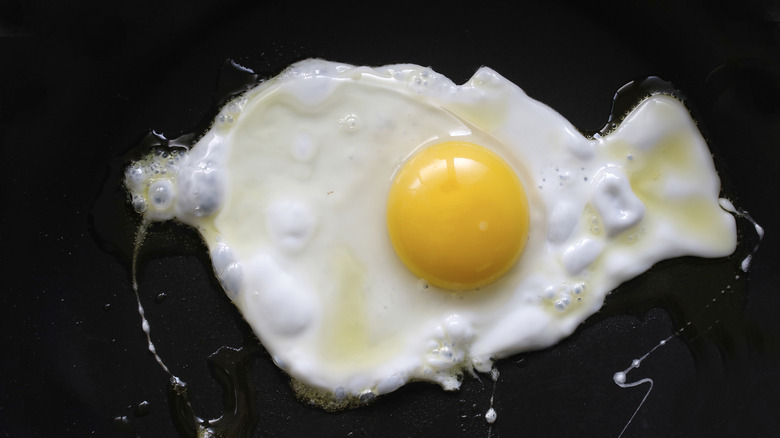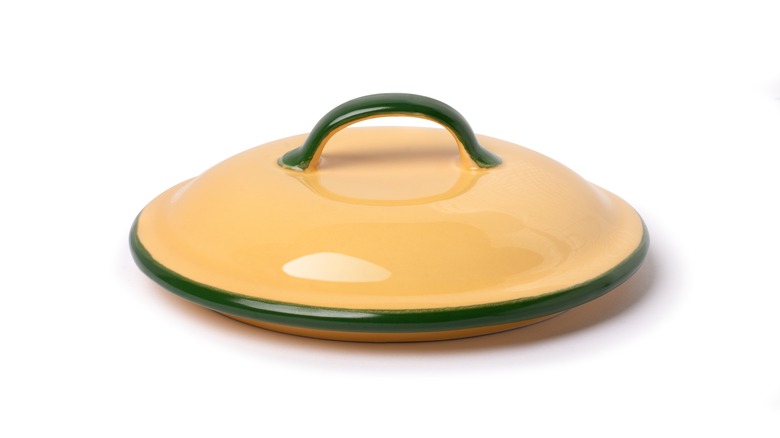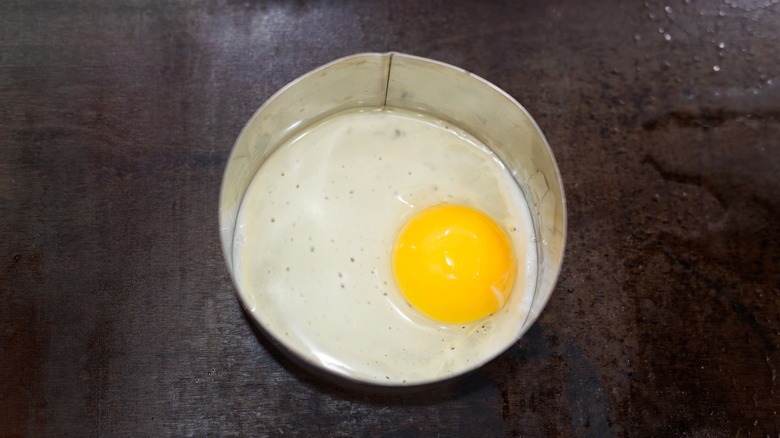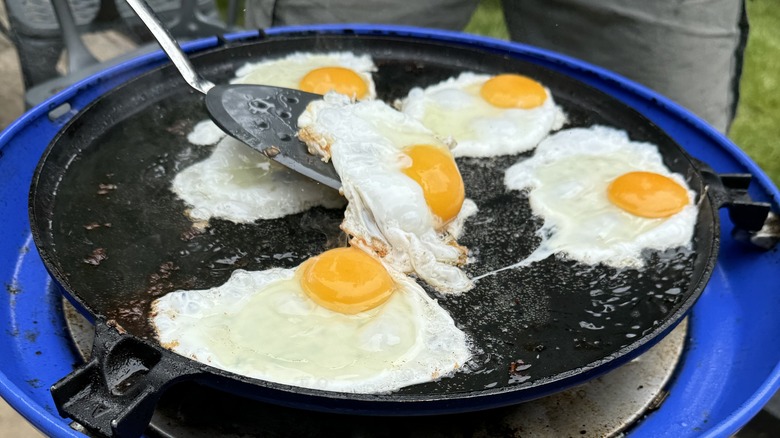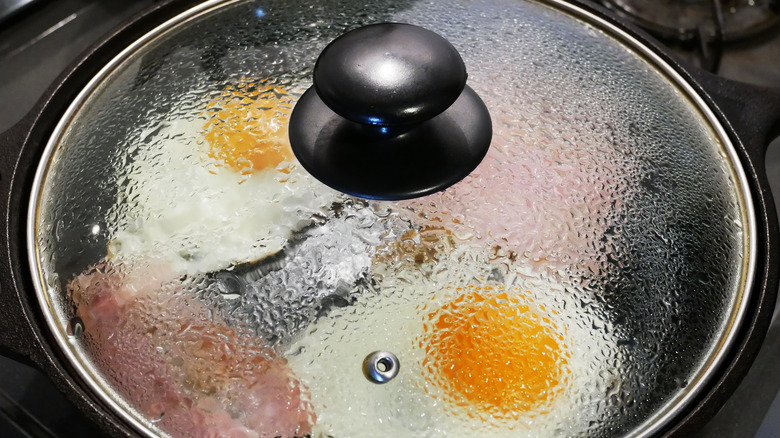11 Common Mistakes To Avoid When Flipping Eggs
Learning how to cook an egg is one of the first rites of passage for a chef. There are many ways this versatile ingredient can be transformed into a culinary delicacy, but a whole lot of them require one key step: flipping the luscious, runny-yolked egg before it's served. While this task may seem simple enough, it actually takes some know-how, finesse, and timing to execute without either cracking the yolk or ejecting the egg onto the kitchen floor. You might already know this from brutal experience; plenty of home cooks have attempted to flip an egg with grace and skill, only to end up with a half-scrambled mess in the pan.
While I've experienced my fair share of egg-related culinary mishaps in my nearly 18 years as chef and owner of a bed and breakfast, I have had plenty of experience and practice flipping them to have learned a thing or two about what not to do. From using the right pan to waiting for just the right moment to go in for the flip, the must-dos are many — and the mistakes to avoid are just as numerous. Allow me to share my expertise with you and transform breakfast from tribulation to triumph.
1. Mistake: Using the wrong kind of pan
Nonstick cookware is the gold standard for cooking eggs. Though this type of cookware has gotten a lot of scrutiny regarding the potential toxicity of PFOAs (perfluorooctanoic acid) sometimes used in their manufacture, when used at temperatures below 500 degrees Fahrenheit, they can be perfectly safe, as testing by Good Housekeeping revealed. Additionally, many American brands of nonstick cookware are now produced without the use of PFOAs, allowing consumers to make informed choices when seeking out a high-quality nonstick pan.
Because cooking an over-easy egg is not something that should be done at a high temperature anyway, this is an ideal place to implement a nonstick pan. The advantage to using a nonstick pan for frying an egg is that it is relatively lightweight, easy to clean, durable, and requires minimal fat to prevent an egg from adhering to the surface of the cooking vessel, making flipping them far less of a challenge.
When selecting the perfect nonstick pan for cooking over-easy eggs, choose one that's big enough. One of the common issues encountered with flipping eggs is that they tend to adhere to one another when overcrowded. Once eggs have fused together, separating them and subsequently flipping them can be nearly impossible. If making more than two eggs, stick with a 10-inch skillet. Any more than four eggs will require a 12-inch skillet. Or, you can cook the eggs in batches.
2. Mistake: Not adding enough fat to the pan
Though one advantage to using a nonstick pan is that they require less fat to cook with, when frying up eggs, some fat is still needed to prevent the eggs from sticking. How much will depend on how many eggs you're cooking. One tablespoon is more than sufficient when cooking two eggs, as long as it's evenly distributed across the bottom of the pan.
Another consideration is what kind of fat to use. Though butter is ideal because it contains the appropriate emulsifiers to create a solid barrier between the eggs and the pan, butter alone has a tendency to burn rapidly. A great option is to use two kinds of fat when cooking over-easy eggs. In this case, equal parts butter and vegetable or grapeseed oil work well because the oil will prevent the butter from burning, while infusing the eggs with its rich flavor.
I prefer using unsalted instead of salted butter to control the salinity of my eggs, but this is a matter of preference. If you really want to get fancy, try using brown butter, which will lend the eggs a savory, nutty flavor and allow the edges to crisp up nicely without burning.
3. Mistake: Not using fresh eggs
Virtually any meal involving eggs benefits from the use of the freshest eggs possible, except perhaps when you hard-boil, scramble, or mix them into an omelet. Among the more unusual facts about eggs is that their consistency changes as they age. Fresh eggs have cloudy whites and are more difficult to peel due to the air cells that develop within their shells. They also tend to have yolks that are firmer and more perky, making them a little more durable and less likely to get punctured during the flipping process. As eggs age, they begin to lose some of this inelasticity and are more likely to flatten when added to the pan. This makes them somewhat harder to flip and more likely to fall apart in the process.
It's also important to bring eggs to room temperature before they're cooked. Cold eggs straight from the fridge are harder to cook evenly, which may make it a challenge to get an even seal on the bottom. This can impact flippability. If you don't have 20 to 30 minutes to leave your eggs on the countertop before whipping up a delicious breakfast, you can bring them to room temperature more rapidly by popping them in a bowl of lukewarm water for up to 10 minutes. Once the eggs are no longer cold to the touch, they should be ready to cook.
4. Mistake: Cracking the eggs directly into the pan
Before expounding upon the many benefits of not cracking an egg directly into a pan, let me be the first to admit that I don't always follow this advice. I despise doing more dishes than I need to, and after nearly two decades as a professional, I seldom have major issues with cracking an egg directly into a pan. That said, I probably should heed my own advice and crack each individual egg into a ramekin before adding it to the pan more often. I do it for poached eggs, but its utility is even more pronounced when you're seeking to minimize yolk damage by cooking an egg over-easy.
Cracking an egg into a small bowl or ramekin before frying it is one of the best ways to guarantee you preserve a pristine yolk. Not only can you ensure the yolk is intact before adding the egg into the pan, you can give the egg a thorough once-over. Check the egg for any imperfections, including blood spots, large pieces of chalaza (the membrane that attaches the yolk to the shell), and any runaway shards of shell that might make their way into the pan, giving the over-easy egg a less-than-pleasant crunchy quality. It also enables you to spread the eggs out into the pan in a more controlled fashion, giving them space to cook without fusing together.
5. Mistake: Using the wrong tool
You know something is a legitimate problem when people start inventing new tools to address the issue. This is the case with flipping a fried egg. A number of unusual egg-flipping franken-tools have been developed that seek to take the difficulty out of flipping an egg. Sadly, I have yet to experience one that works particularly effectively without actually making the situation worse. The truth is, the best tool to use is a simple silicone or rubber spatula that is durable enough for the job without being so stiff it punctures the yolk of the egg.
In this case, size matters. You want a tool that's wide enough for an entire egg to fit on comfortably, otherwise the egg can easily glide right off the spatula. I also like spatulas that have a relatively thin base that tapers. This gives me a little extra scooping capacity to get under the egg without too much effort. If you happen to have a fish spatula, this is an excellent option for flipping eggs, due to its flexibility and extra wide base. Just be sure you get one that is not made from metal, as these can damage the coating on your nonstick pan and introduce potential toxins from microplastics and nanoplastics into your food.
6. Mistake: Cooking eggs at the wrong temperature
One common mistake that may prevent a fried egg from flipping with ease is cooking it at a too-high temperature. In general, eggs benefit from a low-and-slow cooking method. This goes for practically any kind of cooked egg, but is doubly important when you're trying to make an egg over-easy.
To understand why, imagine viewing a nonstick pan under a microscope. What you would quickly see is that, while the pan may look relatively level to the naked eye, it actually has distinct bumps and divots that become more pronounced as the pan gets warm and expands. When an egg is poured into the hot pan, the runny whites sink into these ridges, adhering to them. It isn't until the pan cools down that the ridges become less pronounced, releasing the egg white and making it easier to flip.
Though you could begin cooking a fried egg over a higher temperature and turn it off before flipping it to cool the pan, this may result in overcooking the egg yolk. It is easier to control the cooking process if you begin with more modest heat. This may take a bit longer, but is a surefire way to get a perfectly runny yolk and an egg that won't stick to the pan like Super Glue.
7. Mistake: Flipping them too soon
Timing is particularly important when it comes to flipping an egg. Though the average egg takes about three to four minutes to cook to a firm enough consistency that it can easily be flipped, this is a guesstimate based on a number of shifting factors, from the size of the egg to the pan you're using to the type of range you have (gas versus electric). It would be ideal if you could just set a timer and forget the egg while it cooks, but in reality, you have to pay attention to the changes in the color and texture of the egg white to determine when it is ready for flipping.
An egg is ready to flip when the whites are almost all the way cooked through. This is signaled by the egg white changing from translucent to opaque. But hold up. You may notice that the edges of the egg are set, but the area closer to the yolk is still a little loose. If you attempt to flip the egg at this stage, it is likely that the yolk will get damaged in the process. Remember, the egg will only require 30 seconds or so on the second side to be done, so you do not need to worry about giving the egg enough time to cook. You're simply sealing the exterior of the yolk while allowing the center to remain runny.
8. Mistake: Not using a lid
This egg flipping hack is something that seems like a no-brainer when you actually see it in action. It involves using a lid to help flip multiple eggs at once, which is pretty genius and eliminates the hassle of flipping each egg one at a time. The key is to use a saucepan lid that is both large enough to fit all of the eggs in the pan and is well-greased with nonstick cooking spray. Once the egg whites are set, give the eggs a gentle nudge in the pan to loosen them. Next, carefully glide the eggs onto the upside down saucepan lid. The last step is to place the nonstick pan over the lid and flip the eggs back into the pan to finish cooking.
Perhaps the one downside to this method is that you're adding some fat to the eggs, which can make them a little greasier than they would otherwise be. Additionally, the eggs can end up coming out in a single unit, with the whites of each egg attached to one another. This is relatively easily remedied by gently prying them apart with a spatula before plating the eggs, but it's something to be aware of.
9. Mistake: Not using a mold
If you've ever wondered how restaurants obtain perfectly round fried eggs for breakfast sandwiches, let me introduce you to the ring mold. These stainless steel shaping devices come in many different sizes that can accommodate one or more eggs, depending on your needs. Not only are ring molds useful for creating perfectly round eggs, they're helpful for preventing them from spreading out in the pan too much, which can make flipping a challenge. By containing them into a scoopable, easy-to-flip size, they'll easily fit onto a spatula, making flipping a breeze. The key is making sure you not only grease the pan, but the ring mold itself. If you fail to do so, the egg will adhere to the mold and you won't be able to release it before flipping.
If you don't want to invest in ring molds, there are some alternatives that can perform the same task. Sliced onions are a great natural ring mold that can also be a tasty addition to an over-easy egg. Another delectable option that helps reduce food waste is repurposing leftover mashed potatoes. Simply form them into a ring and pop an egg in the middle. As the egg whites seep into the potatoes, they will begin to crisp up, forming a play on egg-in-the-hole that's sure to solve your flipping dilemma while producing a melt-in-your-mouth breakfast the whole family will enjoy.
10. Mistake: Going too slowly
Speed and confidence are the keys to successfully flipping anything, from pancakes to crepes to eggs. Any sort of loose mass has a tendency to succumb to gravity, so you must be decisive — go in and go fast. Moreover, the second you hesitate, and the longer you allow the egg to balance precariously on your spatula, the more likely it is to slide right off and fall apart. Flipping an egg is not the time to deliberate over temperature, positioning, or anything else; get it done ASAP.
There is a certain artfulness to flipping an egg that takes a little time to master. The wrist action involved in flipping is different from whisking or stirring something. You want to quickly scoop the egg onto the spatula and flip your wrist almost immediately without lifting the egg high in the air. This efficient motion minimizes the risk of the egg flying off the spatula. If you want to practice the technique without wasting a bunch of eggs, start by using a slice of bread. Flip it over and over again until you get comfortable with the movement and speed before graduating to a real egg.
11. Mistake: Thinking you have to flip it
If the prospect of flipping an egg still makes you feel uneasy, fear not. There are a couple of ways you can forego this process entirely and still enjoy an excellent egg. The first involves a method called steam-basting, which is a particularly useful method if you happen to be making several eggs at once. The key to this technique is to cover the eggs in the pan with a tight-fitting lid once they've cooked almost all the way through. The residual steam that gets trapped under the lid will finish setting the eggs, leaving behind a completely cooked white and a delightfully runny yolk. The one caveat to this is that you won't get a crisped-up exterior on the second side of the egg, which many people enjoy. But it definitely takes the stress of flipping the egg out of the equation.
Another option that doesn't require flipping is to pop your eggs in the oven. This is especially helpful when cooking multiple eggs at once. Again, these eggs will lack the lightly crisped exterior of an over-easy egg, being more like a classic sunny-side-up egg, but the result is ideal for topping breakfast sandwiches, huevos rancheros, or your favorite kicked-up avocado toast recipe.
